Question
Case study: R.v.LARSON SCENARIO QUESTIONS Case Study: R. v. LARSON ____ / 10 CM Scenario: In an effort to combat gang activity, the government has
Case study: R.v.LARSON
SCENARIO QUESTIONS
Case Study: R. v. LARSON____/10 CM
Scenario:
In an effort to combat gang activity, the government has passed a law called the Stop Gangs in British Columbia Act (SGBCA). The purpose of this law is to help discourage people from joining gangs, and also to make it easier for police to identify gang members. The legislation was debated for one week in the British Columbia legislature before it was passed by a vote of 61-46. The law took effect immediately.
A provision of this law, s. 49, prohibits all people from wearing bandanas in schools. The penalty under the SGBCA is 30 days in a provincial penitentiary.
Jackie Larson, a seventeen-year old high school student, was wearing a green bandana while walking to school. The principal noticed Jackie's bandana and called the police. Jackie told the police that she didn't know why she was being arrested because she wears her green bandana to raise awareness about the environment.
Jackie's parents hired a lawyer to defend her against the charges laid pursuant to the
SGBCA. Jackie is also bringing a Charter claim, arguing that the law unfairly infringes
freedom of expression under s. 2(b) of the Charter and should be struck down.
A number of advocacy groups have also become involved in the case. An organization known as the Defenders of the Under 20, (DU-20) has been protesting the new law and argue that in addition to limiting expression, it treats young people differently than adults by only applying in schools. Another lobby group called Take Back Our Schools (TBOS) has been advocating for this legislation because they feel that combating youth participation in gangs is a crucial step toward building safer communities.
Jackie was convicted at trial and has appealed the conviction to the Court of Appeal of BC
Task:
You are a judge of the Court of Appeal for BC. You and your colleagues have just heard this case and ruled that s. 49 of the SGBCA violates s. 2(b) of the Charter. You must now determine if this infringement is justified under s. 1 of the Charter.
Use the following organizer to record your ruling for each step in the s. 1 analysis. Provide justifications for your decisions. Once you have completed all of the steps in the s. 1 analysis, give a final judgment on whether or not the Charter infringement is justified under s. 1.
Explain the method the government is using to achieve their objective. (This is the law or the government action itself)What is the intention of the law?
Explain whether the process or approach to apply the law is reasonable and linked to the objective.
Does the method being used actually achieve what it is supposed to?
Has the impact on the rights of individuals or groups been minimal?
Ex:Is there another way equally as effective, for the government to achieve their objective without impacting this group?
Is there more benefits to society because if the law? Does the benefits of the law outweigh the negative impact?
Is the severity of the charter violation relative to the objective? Does it make sense?
Ex: If we were to weigh the violation of the charter with the objective the government is attempting to achieve, does the objective carry more weight?
Step by Step Solution
There are 3 Steps involved in it
Step: 1

Get Instant Access to Expert-Tailored Solutions
See step-by-step solutions with expert insights and AI powered tools for academic success
Step: 2

Step: 3

Ace Your Homework with AI
Get the answers you need in no time with our AI-driven, step-by-step assistance
Get Started


